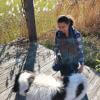Troubleshooting: Trophy Cam Agressor
26 November 2018 6:53pm
26 January 2019 7:24pm
Neil was who I was thinking of. I'm not sure when he plans to next be here.
Peter
26 January 2019 11:39pm
Hi Peter, Ok cool, I'll ask him. I know Lucy is heading back over in a couple of months for sure though, so happy to give it to her for you.
Cheers,
Rob
Community Office Hours: Wednesdays and Fridays
25 January 2019 3:01pm
Avisona 2019: Workshop on Bird Call Recording and Analysis
24 January 2019 12:00am
Drones with thermal imaging
21 January 2019 10:34am
On the horizon: Looking ahead for global conservation
 Sarah Pocock
Sarah Pocock
18 January 2019 12:00am
FLIR and World Wildlife Fund Announce Effort to Combat Rhino Poaching in Kenya
 FLIR Systems, Inc.
FLIR Systems, Inc.
18 January 2019 12:00am
Drone based orangutan tracking
12 January 2019 6:51pm
14 January 2019 11:42am
Hi Dirk,
Your case study is an interesting read, thanks for sharing. In terms of people exploring similar things, there are a few members who you could connect with about different elements of the project. Your project has a few different elements - are there specific things you're interested in hearing how others are handling?
As a start:
- @Sol+Milne is working with Drones and Orangutans, but using them to map nests rather than track individual animals. Case study here, discussion about the project here.
- There's a discussion in this group about aerial platforms for wildlife tracking that might be relevant, which @Albin , @YvanSG , @Rob+Appleby and @emjay are involved in. In a spinoff thread, @emjay has shared the details of WildFInd, a package that produces geo-referenced heatmaps for VHF collared animals - sounds like this could be relevant for your project as you're using VHF implants as well, right? He's invited feedback to help move that project forward, so might be worth checking it out to see if it's relevant and there is overlap between your work.
- @Tomswinfield has been working with drones in Indonesia for the past few years to map forest recovery efforts (case study here - it's a bit dated but gives you an idea what he's exploring).
- @meganossmann has been testing out FLIR’s new Duo Pro R thermal camera as a detection tool for loggerhead sea turtle nests (case study here, discussion here).
This is by no means an exhaustive list of members working in this space, but it's a enough to point you in the direction of some of the recent work being shared here that seems to overlap with what you're working on.
If you haven't already, I'd also recommend having a poke around our drones group as well as there might be some relevant discussions/projects that could be of interest.
Steph
14 January 2019 11:06pm
Hi Dirk,
Sounds like an absolutely fascinating project and well done on all the progress you've made! If you aren't already aware of it, I think the Sensorgnome system people and you have some definite things to chat about. Sensorgnomes use Pis/Beaglebones and RTL-SDRs (or FUNcubes) and custom written software to automatically tracking beacons. The system is primarily used for ground stations, and there's a lot of emphasis on the small Lotek coded VHF tags, but conventional tags also work and there's a lot of interest in the community about drone tracking as you'd expect. Anyway, great stuff and welcome to WILDLABS!
Cheers,
Rob
16 January 2019 11:59am
Thanks all, very useful links, some of them, like the orangutan nest mapping, wildfind, & sensorgnomes, I knew about, some not. Will have a poke :)
[Invite] Digital Naturalism Conference / Residency / Workshop
15 January 2019 9:34pm
Advice for pilot regen project (New Forest, UK)
4 December 2018 12:20pm
15 January 2019 9:04am
I know this might be controversial but why do anything - why not let nature do it's thing and just observe. That way it would establish a baseline and help to formulate acellerator interventions for other sites. Although Knepp has started from a different base it's an interesting story in low intervention rewilding https://knepp.co.uk/
15 January 2019 9:23am
Thanks David,
I understand your point, but we are now collaborating with University research that will be examining (amongst other things) the microbial level, especially in poor and polluted environments. The request still stands, and any relevant collaboration would be welcomed.
All the best.
Tiny birds, tiny tech
15 January 2019 12:00am
Sumatran Forest Type Maps and Data
9 January 2019 5:43pm
14 January 2019 10:26am
Just to throw a couple options out there:
The hanson map, which you can download from:
Global Land Analysis and Discovery
You could also make your own map from the raw satellite data but that is a bit more involved.
Tom
The Ecosulis Rewilding Tech Challenge
 Ecosulis
Ecosulis
14 January 2019 12:00am
HWC Tech Challenge Update: Testing our prototype thermal cameras in the Arctic
 Arribada Initative
Arribada Initative
9 January 2019 12:00am
31 March 2023 1:24pm
Conservation X Labs is hiring!
8 January 2019 12:32am
Wild pigs crop damage assessment and movement using GIS and drones
28 December 2018 5:15am
3 January 2019 9:57am
Dear Sdorji,
Thanks for sharing! Are you specifically looking for monitoring methods? In that case, you could probably also find relevant information outside of the HWC group, perhaps in groups focussing on camera trapping, the use of drones etc on the other WILDLABS pages. Do you know about the Bhutanese national HWC strategy? Does this also focus on wild boars? Or is your initiative not connected to that?
Best regards,
Femke
5 January 2019 8:24am
Dear Femke,
I am actually looking for studying the crop damages using drones and also tracking the movements, may be using GPS collars. But I do not actually know about these tools and have not used. So just thought if I can get methods and procedures. It is great that you already know about our national strategy. Yes, I am the core member of Bhutanese national HWC strategy and we have recently completed drafting. I have worked on wild pigs chapter and one strategy there is crop damage assessments and movements study. We are also proposing crop insurance but without a concrete data, there is nothing we can do about crop insurance. So I am thinking to collect basic information such as crop damages and movements of wild pigs.
Locally fabricated electric/solar fencing widely spreading in Bhutan
28 December 2018 5:57am
3 January 2019 9:57am
Dear Sdorji,
Thanks for sharing and your request for suppport from this group! I was thinking that perhaps @Mohan+Raj could share with you some insights from India? He has also developed fences and is involved in the technologies to improve monitoring and maintanance.
Best regards,
Femke
5 January 2019 8:18am
Dear Femke,
Thank you for your email. I hope I can hear from Mohan Raj. Electric fencing is one area where it can play very important role in human wildlife conflict management. In Bhutan, there are now about 3636 km and we are already experiencing some issues such as sustainability, wooden poles, nelgect during off-season, etc. I hope we can learn from each other and see areas for collaboration.
Thanks.
Sangay
How camera traps help reduce tension between farmers and cheetahs in Botswana
2 January 2019 2:31pm
Recording problems with Audiomoths
30 December 2018 9:57am
2 January 2019 3:00am
Hi David
Thank you for your answer. I'm using 2000mAh Fujitsu R06 batteries. When configuring the AudioMoths, daily energy consumption is said to be 72mAh. The batteries should last for at least 20 days. I've never had them deployed for more than seven days straight (and they even did the zero lenght files at deployment for only three days). Maybe the energy consumption calculator in the configuration program is faulty?
Where can I find the firmware?
Alex
2 January 2019 7:49am
Information and links to the new firmware and the app is here https://www.openacousticdevices.info/single-post/2018/12/12/Version-120---New-Firmware-and-Config-App-Now-Available. Note: there is a possiblilty of the update failing and the recovery proceedure is here https://www.openacousticdevices.info/support/device-support/device-bricked-during-firmware-update.
With batteries it is also to do with voltage decay as well as power. There was a discussion Nov 2017 about voltage limits and it was said that SD cards get a bit twitchy at less than 3.3v but the rest will still be operating at around 3v - I can't find any data on R06 however in general voltage drop is influenced by temperature, dicharge rate, age/no of recharges etc etc - your are right it may not the batteries but there is a possibility it might hence my suggestion.
I'd suggest also posting on the AudioMoth support forum, to see if anyone else has seen this issue and has a fix.
Cheers
David B
2 January 2019 10:01am
Forgot to say - if you are having trouble reformatting SDcards on Windows- the project suggests this programme http://www.ridgecrop.demon.co.uk/index.htm?guiformat.htm.
News from around the world
21 December 2018 9:28am
Integrating GPS trackers and accelerometers to examine the movement ecology of possums in fragmented landscapes
20 December 2018 10:12pm
Machine learning to detect fish bomb blasts
20 December 2018 1:16pm
3D printed audiomoth cases
18 December 2018 10:14am
rOpenSci Community Call - Governance strategies for open source research software projects
10 December 2018 5:18pm
New trends and behaviors: Discussion
10 December 2018 2:22pm
Upcoming events
10 December 2018 2:21pm
Open spots available at SMART Advanced Training in Zambia January 2019
6 December 2018 1:13pm
Introductory online training videos in bioacoustic analysis using Raven
5 December 2018 10:43am
Good Reads?
24 October 2017 4:54pm
30 November 2018 4:27pm
Keeping this thread active.
POACHED - Inside the Dark World of Wildlife Trafficking
by Rachel Love Nuwer
This is super interesting, and gives a really good look at poaching. Rachel goes in depth and reports back from the field, including an inside look at the CITES meetings. This opens lots of issues that need to be addressed.
1 December 2018 3:27am
There are two great articles about the issue of bird poaching in the Mediterranean and its serious threat to Palaearctic bird populations by Jonathan Franzen.
A 2010 article in the New Yorker,
https://www.newyorker.com/magazine/2010/07/26/emptying-the-skies
and a 2013 National Geographic feature,
https://www.nationalgeographic.com/magazine/2013/07/songbird-migration/
I wrote a 2017 blog post for National Geographic about the topic of bird poaching in Cyprus,
https://blog.nationalgeographic.org/2017/11/21/can-anti-poaching-activism-save-25-million-birds-a-year/
Regards,
Jason
4 December 2018 6:47pm
Your blog post was great. keep up the good work!
Michael
can we detect gillnets in turbid water?
27 November 2018 4:12pm
4 December 2018 2:55am
Hi Aurelie,
I do some work in underwater robotics and it's a tough problem! Maybe there is a way around the problem instead of through. May I ask, is the goal specifically to map where the nets are within a certain stretch of river, or to be able to ensure there are no nets wihin the area, or...?
Thanks,
-harold
4 December 2018 9:01am
Yes, I agree it's a tough problem - i'm certainly stumped ;)
but thanks so much for your reply and counter question - the goal is to find these gillnets and remove them...and we don't want to be pulling up every net and buoy...
Monitoring Ecosystems through Sound: The Present and Future of Passive Acoustics
 Ella Browning
Ella Browning
4 December 2018 12:00am


















25 January 2019 3:21am
Ok no problem Peter. My colleague Neil Jordan works in Botswana, as does Lucy Ransome (who is heading there in April). Otherwise, do you have a contact I can send it to so they can get it to you?
Cheers and thanks again for the interest.
Rob